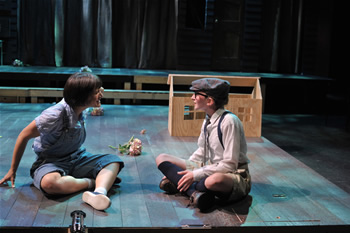The string faculty of the University of North Carolina School of the Arts have been busy these days – exactly one week ago they participated in the annual Mozart’s Birthday concert, and the naming of the new Reynolda Quartet took place this Saturday, opening with the world premiere of Lawrence Dillon‘s new string quartet, “Last Spring.” A repeat performance will take place Sunday afternoon at 3PM.
One of three members of the composition faculty of the UNCSA School of Music, Dillon has written a charming one-movement work with a three-part form that both intrigues and ultimately satisfies. A gentle muted “Andante pastoral, pleasantly warm” begins and ends the work, punctuated by shrill ponticello tremolos mostly played by the second violin, but eventually infecting all the instruments. In the stormy mid-section following, which Dillon entitles “Più mosso, exuberant and brutal,” mutes come off and a percussive rhythmic interplay (“hard, hard…, fast-fast”) repeatedly dominates what could be the allegory for winter interrupting spring to which Dillon alluded to in brief introductory remarks before the performance. But in the end the pastoral section reappears with one more final note which concludes the work.
The second work on the program was the Second String Quartet of Czech composer Leoš Janáček (1854-1928), subtitled “Intimate Letters,” referring to the hundreds of love letters he had written over a ten-year period to a much younger (and happily married) woman of his acquaintance. This quartet is famous and holds a special place in the repertory of string quartets. The four instruments are often treated as separate characters in dramatic situations.
“Intimate Letters” is written in four movements, Andante, Adagio, Moderato (with vestiges of the traditional Scherzo with various triple meters prevailing and ending in a short and fiery coda) and finally the folk-song-inspired Allegro which closes the quartet with several allusions to Moravian sentimental love songs lending a Mahler-ian cast.
Several techniques are notable – repeated short fast patterns almost like verbal chatter, long moments of preparation before the statement of a theme (similar to Sibelius’ introductions of partial themes, to be tied together as the work progresses), striking colors such as ponticello, whole-tone scales of harmonics in the Adagio (dreamy, like an off-key Papageno) and sudden alternations of smooth calms interrupted by outbursts.
After intermission the Reynolda Quartet played the second of Brahms’ three string quartets, Opus 51, No. 2, in A minor. The sell-out audience was caught unprepared when the musicians appeared on stage without warning while they were milling around. This awkwardness carried through part of the first movement (Allegro non troppo) – until the entrance of the friendly trochaic second theme played in thirds, bringing a smile to many faces.
The Andante moderato mid-section played violin versus cello while the second violin and viola accompanied with chattering commentary. The third movement, Quasi Menuetto, has in common with the third movement of the Leoš Janáček the nod to tradition, but only a nod as the “trios” which separate sections of the minuet form were in fast duple meters, unlike their antecedents.
The fourth movement of the Brahms also makes use the folk-music dear to composers – in the case of Brahms, Hungarian folk music – a fast waltz-like tune with hemeola cross rhythms and a preponderance of three-bar phrases – ending in a final fast recap of the theme over pizzicatos and a short unison. The audience showed its appreciation in a cheering standing ovation!
The UNC School of the Arts has not had a permanent resident string quartet since the dismantling of the Razoumovsky Quartet, following the demise of David Moskowitz, second violin. Now the long-term and steady on-campus presence of violinists Ida Bieler and Janet Orenstein, violist Ulrich Eichenauer, and cellist Brooks Whitehouse has allowed the school the luxury of its own string quartet! And these musicians have so much going for them – beautiful tone, guts and fire and passion! I look forward to their next performance!
The quartet is named for the Reynolda House, the long time residence of the tobacco magnate R. J. Reynolds and his wife Katherine. The home now houses a fine collection of American art and is located in the popular recreation area, Reynolda Gardens, adjacent to the main campus of Wake Forest University.
In recent years, a nice concert/lecture hall with collapsible seating has been built onto the east wing of the house. As with most multi-purpose halls, the acoustics are less than ideal for small homogeneous chamber groups such as a string quartet. This was more noticeable in the second half of the concert where the quartet of Brahms makes greater use of the unifying nature of the strings than in the first half where both works took great advantage of the individuality of the instruments. I at first wondered if the first violinist Bieler had chosen to play the Brahms on a different violin! Perhaps my seat at the extreme end of a row explained why the two violins (who generally faced me) were louder and more distinct than the viola and cello (whom I viewed three-quarters to the back).
As mentioned above, this concert repeats Sunday afternoon, February 2 at 3 PM. See sidebar for details.













